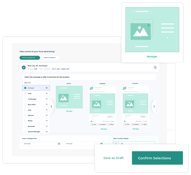Hiring is slow, how can our marketing team help with recruitment marketing per location?
This year, recruiting has been a challenge across many industries, particularly for restaurants....

Although being physically together may not be in the cards for as many consumers this upcoming holiday season, the magic of togetherness and gift giving can still be in the air — it’s just up to us as retail marketers to help make that happen.
The holiday season is a time when new shopping behaviors typically emerge. As the COVID-19 pandemic has brought changes to many aspects of life, new habits formed at this time will likely shape trends for the 2020 season and beyond.
As a modern brand marketer you need to be able to rely on both past historical data and these new consumer trends to make the best marketing decisions for your brand. While the overall economy has suffered from pandemic-necessitated behavioral changes, some industries have been hit harder than others. It’s expected there will be a 10.5% decline in total US retail sales this year, with a 14.0% drop in brick-and-mortar sales due to social distancing measures. Ecommerce, however, is poised to grow 18.0% according to eMarketer, following a 14.9% gain in 2019. While the shift to ecommerce will accelerate digital sales to new heights, retailers will grow their US digital display ad spending by only a sluggish 2.3% this year. Retail advertisers—which make up the largest share of display spending—will boost these investments by just $300 million this year, in spite of increased ecommerce spending by consumers, according to eMarketer retail.
Successful marketing during this critical and challenging time will rely on powerful principles: Planning, Technology, Data, and Personalization. For multi-location retail brands who need to focus on both national and local marketing, despite shrinking budgets and fewer resources, having a multi-location marketing platform may prove to be the tech gift that keeps on giving.
In this article we’ll cover three considerations retail brands should keep in mind when executing consumer holiday marketing campaigns in 2020.
While it’s important to plan your marketing strategies in advance of every holiday season, this one feels even more important. After all, 40% of consumers begin holiday shopping and planning before Halloween so it’s imperative that you’re ready to go now. However, it’s equally important to remain agile and be prepared to adjust on the fly as trends continue to emerge and change in the post-COVID marketplace of 2020.
If you’re working with an ad agency and haven’t seen a Q4 plan, be sure to pick up the red bat phone immediately. Your agency should be actively engaged and developing a media planning and buying strategy now for the upcoming holiday season. Whether you’re using an agency or executing in-house, you’ll also want to look at your creative and budgets a bit differently in 2020.
As you’re building creative for traditional or digital media, this year will be especially important in terms of creating multiple ad versions for your asset library. If you’re a multi-location retail brand, your local locations may have different needs depending on community preferences, popular local holiday promotions, and local COVID regulations. Also, consumers now expect a more personal and relevant message. As consumers are being inundated with ads, seeing locally relevant ad creative and; even better, dynamic ads that pull in local first party data into the content, will help you stand out in a cluttered field and avoid over saturating consumers with the same ad which may not even be meaningful to them.
From a budgeting standpoint, begin allocating and setting your digital marketing budgets now and slowly ramp them as the holidays approach. When building and optimizing campaigns in today’s current digital marketing landscape, targeting customers at the regional or DMA level is no longer good enough. For all retail locations to receive an ROI commensurate with their spend, consider creating individual campaigns with individual budgets.
Also, consider how you want to approach your bidding and bid adjustments during these turbulent times. Smart bidding strategies are set and automated at the campaign level based on your bidding goal, however retail advertisers aren’t able to adjust those bids manually. If you’re using manual bidding or enhanced CPC bidding, your individual bids can be set and adjusted at the ad group or keyword level. While more tedious, it will benefit your campaigns more in the long run. Once you begin accruing performance data from your campaigns, you’ll want to start setting bids at the keyword level. While you previously may have been okay putting your campaigns and bids on autopilot, you’ll now want more control and to be able to prioritize keywords based on performance during this COVID holiday season. You’ll also want to keep a closer eye on making bid adjustments based on device, location, interaction, remarketing, etc.
A good starting point for planning is to carefully start using your data to uncover trends and insights around shopping behavior during the 2018 or 2019 holiday season. While past engagement, lead, and sales conversion date shouldn’t be your north star, layering on consumer behavior in response to COVID-19 over the last six months along with observations from past economic downturns can help you develop a sound marketing strategy.
Many consumers’ shopping behaviors have moved online in recent months, and that trend is likely to continue through the holiday shopping season. From a consumer trend perspective, consider the following when building out your holiday marketing plan:
From a multi-location retail brand marketing standpoint, It’s important that national and local digital marketing campaigns are planned and structured to be symbiotic. That they work together, versus competing, to avoid wasting spend. By using technology and local data, brands can cost-effectively and accurately understand every market area they serve while building local audience profiles and retargeting pools for every location. As a multi-location retail brand, you can now build a referenceable library of market area specific data to understand your most valuable customers and engage new customers. You’ll also now be able to better understand where advertising has the most meaningful impact and where it has no impact at all. You can SAVE MONEY and only spend dollars where they actually matter!
From a creative or messaging perspective, retail marketers should use historical trends and real-time insights to create intent-based content. Leverage the power of macro-level (market insights) and micro-level (historical trends and real-time insights) data. Using this data-driven approach allows marketers to model search intent at every point of the customer journey and across multiple channels. While you should focus marketing strategy and budgets on ROI-positive marketing tactics and historical performance, it’s important to continue to TEST in order to effectively optimize campaigns as consumer behaviors and buying patterns will continue to evolve. Let data be your guide and follow this agile approach for executing holiday campaigns successfully.
According to May 2020 data from daVinci Payments, 71% of US adults said they planned to do more than half of their holiday shopping digitally this year. 50% of all internet traffic is on mobile and 56% of holiday spending in 2018 was from mobile devices.
From a local perspective, some 82% of smartphone users turn to search engines to find local businesses, and nearly one third of all mobile searches are related to location, according to Google. Mobile has become a central part of each stage of the customer journey, influencing 56% of offline sales, and more than $2 trillion in retail sales in 2017. US consumers are using their mobile phones to look up information and guide them every step of the way to the cash register. Local marketers, from SMBs to national brands, need to reach these potential customers in their moments of expressed intent, which means adopting a mobile centric strategy.
However, given that retailers are slowing down their digital spending ahead of the holiday season compared to previous forecasts, it’s going to be imperative that they market smarter and add more value to customers, especially on mobile, if serving them ads. The ads you do serve should provide value, be locally-focused with relevant messaging, and call out services or promotions that will help solve a customer problem. They should tell a story and make a powerful connection.
However, keep in mind, COVID-19 has also shifted consumers’ definition of “value”. To make a relevant connection with a consumer who may prefer “buying or going” local, may be facing financial constraints, and is now more concerned with safety when shopping, the ability to add value to your marketing both nationally and now locally has never been more crucial. Consider these stats from Total Retail. In place of shopping on Amazon during its reduction in shipping non-essential items, 65 percent of consumers reported purchasing from major retailers, 35 percent reported supporting local businesses (consumers over 60 most frequently reported doing so); and 31 percent reported purchasing directly from brands.
To adapt to new expectations during the 2020 holiday season, retail businesses should consider offering BOPIS including curbside pick-up if they’re not already. An average of 56% of global holiday shoppers surveyed by Facebook care about the ability to BOPIS when shopping, up 19% from 2018-19. Additionally, usage in click and collect has surged—specifically curbside pickup—which has allowed shoppers to make immediate purchases while minimizing human contact. This buying method is also likely to increase during the 2020 holiday season. eMarketer had previously forecast that US click-and-collect ecommerce sales would increase by 38.6% this year. Now, they expect growth to be 60.4%, with sales reaching $58.52 billion.
For many price-sensitive shoppers and those on lower budgets due to COVID’s economic and unemployment impact, promotions or mega sales could be the shopping events they’re waiting for. Nearly 1 in 3 global respondents to Facebook’s survey say they’ll wait for products to be on promotion, discount or sale before purchasing. Last year, an average of 54% of global holiday shoppers surveyed purchased something during a mega sale event, and more than 43% of respondents shop for deals on Black Friday. This year, they anticipate a significant increase in global participation in mega sales events driven by an increased appetite for deals coupled with a preference to minimize in-store shopping.
Identify what products, services, and promotions are most meaningful to your national and local customers, and ensure your digital ads provide value by helping them get what they need, when they need it. Improve the customer experience throughout the buyer’s journey.
In Conclusion
This year’s holiday season will undoubtedly feel different compared to years past. In light of everything that has happened throughout 2020, people will feel grateful for what they have and treasure spending time with family and friends. For this reason, the holidays will still be a time to shop, gift and celebrate. As you plan your digital marketing campaigns and craft your messages, use these insights to understand people’s evolving shopping concerns and new behaviors. This year, retail brands have the opportunity to be part of people’s stories and convert them into lifelong brand advocates as we navigate through this trying time and attempt to reconnect with loved ones.


This year, recruiting has been a challenge across many industries, particularly for restaurants....


When it comes to the biggest problems franchise marketing executives face at the roundtable,...